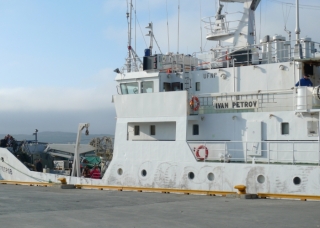
The system built to manage Russia’s nuclear legacy is crumbling, our new report shows
Our op-ed originally appeared in The Moscow Times. For more than three decades, Russia has been burdened with the remains of the Soviet ...
News

Publish date: September 9, 2014
News
Russian authorities conducting a joint mission with Norway to assess a nuclear submarine that sank more than a decade ago are saying the vessel – the infamous K-159 – posses no radiological threat to waters at the bottom of the Barents Sea, the official Russian agency ITAR TASS reported today.
According to Vyacheslav Shpinkov, the head of the joint mission, radiation background levels surrounding the nuclear submarine, which sunk in August 2003 while under tow to Polyarny shipyard near Murmansk, do not exceed norms.
The sinking of theK-159, which was being pulled by tugboat from the Gremikha Russian naval installation for dismantlement, killed nine sailors who were aboard the rusted hulk to patch leaks along the way.
When it foundered, it pulled 800 kilograms of spent uranium fuel with it to the ocean floor, causing a panic among the fishing community who depend on the fertile waters at the mouth of the Murmansk Fjord.

The mission of 15 scientists from Russian and Norway to inspect the vessel’s radiological condition was largely to allay – or confirm – fears of radioactive contamination. The last time the vessel was inspected in detail was during a joint British-Russian expedition in 2007.
“We conducted visual and instrumental inspections of the submarine with the help of remote controlled submersible apparatus, measured gamma exposure with a spectrometer, took water samples, seabed samples, of live organisms in the immediate area of the submarine’s hull,” Shpinkov told the agency.
He said the Russian-Norwegian scientific crew would be presenting their final results in a year, but that the expedition had conducted a so-called express analysis of the collected samples from around the vessel to determine the presence of radioactive contamination, which he said revealed the vessel “so far, remains in a safe state.”
“No emissions of radioactive substances outside the hull of the vessel were detected,” Shpinkov said, according to ITAR TASS.
The mission is comprised of Russian and Norwegian scientists, given the K-159’s proximity of 130 kilometers from Russian authorities. In total, 15 scientists are taking part in the trip.
Members of the expedition from the Norwegian Radiation Protection Authority, which has crew aboard the Ivan Petrov research vessel to inspect the K-159’s wreckage lying 246 meters underwater, could not immediately be reached for comment.
The NRPAs official website also carried no new statements regarding the Russian announcement or the expedition as a whole, which set out on August 22 and is expected back in port in Arkangelsk, Russia early this month.
Raising the nuke sub: Russian and Norwegian takes
Russia has typically been quick to assert that the K-159 poses no danger where it lies, while officials with the NRPA have long insisted environmental and feasibility studies must be done to assess the possibility of raising the nuclear sub from its deep watery grave.

The good news is that there is no increased radiation at the moment,” said Nils Bøhmer, Bellona’s managing director and nuclear physicist. “What we need to do is to find out more about the technical condition of K-159 in order to constitute a risk-assessment for a potential lifting operation,” he said, continuing that, “The consequences of letting the submarine wreck stay at the sea-bottom should also be assessed.”
Ingar Amundsen, head of section at NRPA, told Bellona precisely that in an interview preceding the departure of the Ivan Pavlov, and said he hoped the current expedition’s analyses would provide necessary data on how the vessel can safely be brought to the surface.
“What we believe is important is to make an environmental impact assessment of a potential raising operation,” Amundsen told Bellona. “The submarine contains a great deal of radioactive material and sooner or later it will leak, but we need to get a good picture of where things are at current in order to make an in depth environmental impact study of such an idea.”
He also said that it the financial burden of raising the submarine should be Russia’s, but also encouraged international donors who have in the past helped with nuclear remediation projects in Northwest Russia to do it again.
More radioactive fish in the sea
The K-159 is by far not the only hazards packed with nuclear material and radioactive waste lying at the bottom of Arctic waters abutting Norway’s coast.
An accumulation of reports from Russia to the NRPA reveal the Soviet and Russian Navies littered the Kara Sea with all manner of nuclear and radioactive waste over several dozen years, stopping in the early 1990s.
According to NRPA, a catalogue of Russian nuclear waste in the Kara Sea released in 2012 includes 19 ships containing radioactive waste; 14 nuclear reactors, including five that still contain spent nuclear fuel; 735 other pieces of radioactively contaminated heavy machinery; 17,000 containers of radioactive waste, and the K-27 nuclear submarine.
“The scope of spent nuclear fuel, reactors and radioactive waste on the seabed in the Kara Sea and the Russian part of the Barents Sea is large,” Per Strand, NRPA’s director, said in a release prior to the Ivan Petrov’s setting sail.

Our op-ed originally appeared in The Moscow Times. For more than three decades, Russia has been burdened with the remains of the Soviet ...

The United Nation’s COP30 global climate negotiations in Belém, Brazil ended this weekend with a watered-down resolution that failed to halt deforest...

For more than a week now — beginning September 23 — the Zaporizhzhia Nuclear Power Plant (ZNPP) has remained disconnected from Ukraine’s national pow...

Bellona has taken part in preparing the The World Nuclear Industry Status Report 2025 and will participate in the report’s global launch in Rome on September 22nd.